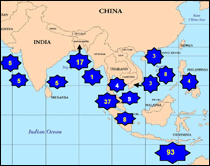 |
 |
 |
 |
|
Piracy, 1 Jan to 31 Dec 2004, in SE Asia, Indian Sub Cont and Far East. |
|
Maritime piracy has made a striking comeback in recent months - most
notably in Southeast Asia and the Malacca Straits. More than 600
vessels a day pass through the Malacca Straits, making it one of the
world's busiest, and most piracy-prone, sea ways. This vital trade
route is the shortest connection between the Indian and Pacific oceans.
Many of the ships passing through the Straits are oil tankers or are
carrying other potentially dangerous cargo, and their vulnerability
raises concerns that international terrorists might hijack such vessels
with the intention of ramming them into port cities. Given the
importance of international shipping to the global economy, maritime
piracy has become a high priority for military and police throughout the
world. The International Maritime Bureau (IMB), established in 1981
to act as a focal point in the fight against all types of maritime crime
and malpractice, notes that in addition to the growth in piracy, pirates
have become more ruthless, using more guns and kidnapping more people
than ever before.
From CIAO's database:
The Growing Threat of Maritime Piracy
Future Trends in Worldwide Maritime Terrorism (PDF)
Maritime Order and Piracy
Contraband Trades of Southeast Asia
Outside Links*:
International Maritime Bureau (IMB)
http://www.icc-ccs.org/imb/overview.php
Asia-Pacific Area Network
http://www.apan-info.net/maritime/key_piracy_view.asp
Division for Ocean Affairs and the Law of the Sea, United Nations
http://www.un.org/Depts/los/index.htm
Malacca Straits Research and Development Centre
http://www.fsas.upm.edu.my/~masdec/web/straits.html
* Outside links are not maintained. For broken outside links, CIAO recommends the Way Back Machine [http://www.archive.org/].
|
 |